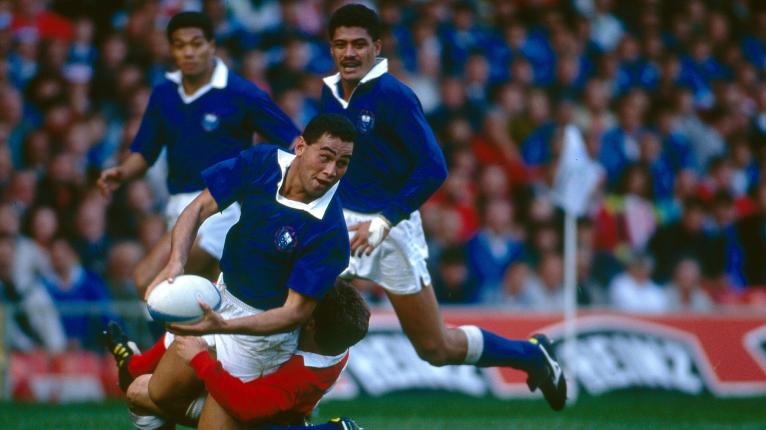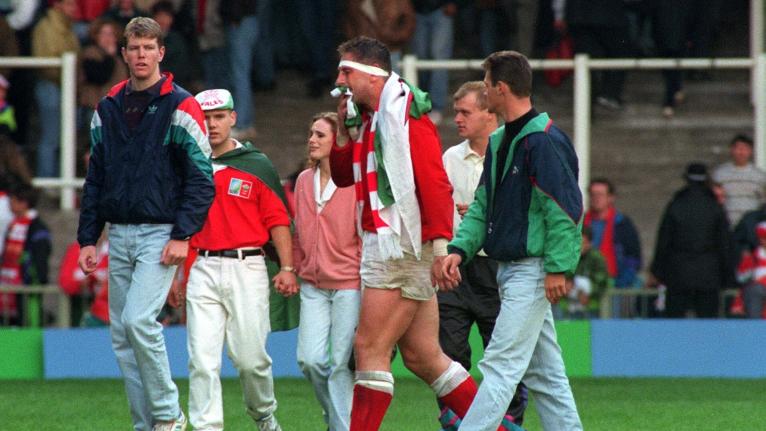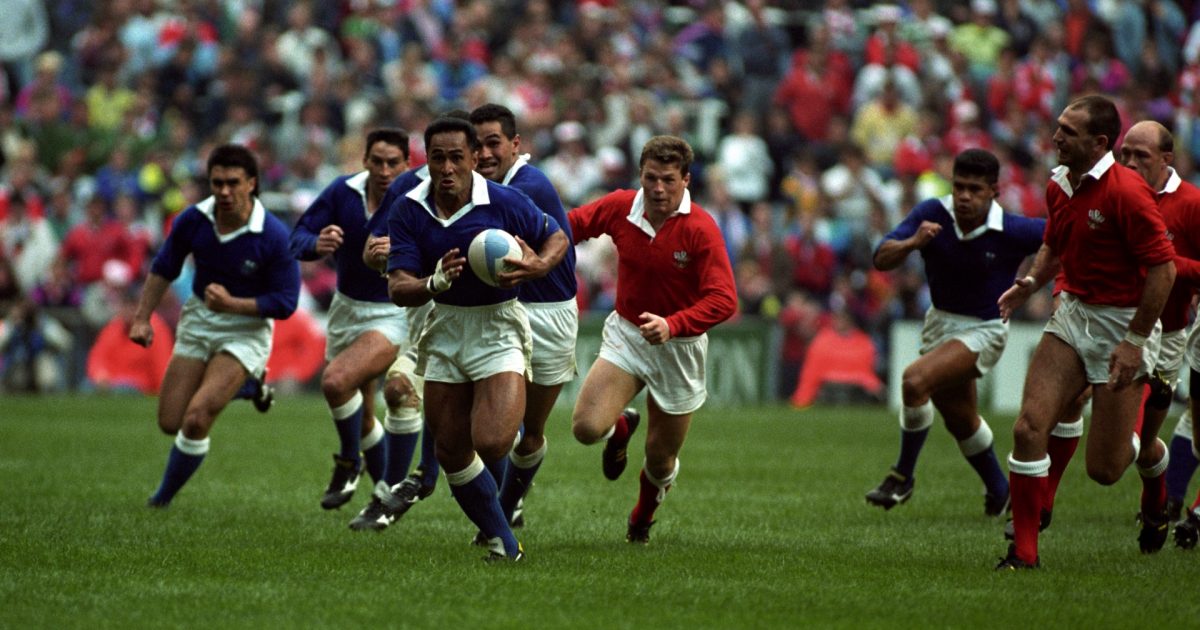'We were the poor cousins': Samoa's 1991 World Cup upset 30 years on

To this day it’s still the standout highlight in the stellar career of Pat Lam. The venerated Aucklander enjoyed a swashbuckling time playing in New Zealand and England before going on to forge the coaching adventure that now has him at the helm of ambitious Bristol. However, nothing has yet to eclipse the magical moment from 1991 when Western Samoa shocked the world with their World Cup win over Wales in Cardiff.
It was October 6 30 years ago when the Test debut-making Lam was part of a blue-shirted hit squad of smiling assassins that included Apollo Perelini, Frank Bunce, Brian Lima, Stephen Bachop and the late great Peter Fatialofa. The Pacific Islanders emerged with a thoroughly deserved 16-13 Arms Park upset and it prompted one of rugby’s more famous ever quips, ‘Thank heavens Wales weren’t playing the whole of Samoa’.
Two weeks later, having only narrowly been beaten by eventual champions Australia at Pontypool and then doing a clinical number on Argentina in Pontypridd, the Samoans were taking on Scotland in the quarter-finals. Their odyssey came to an abrupt end at Murrayfield, but they exited with their status transformed and a thirst among fans for every World Cup to be blessed with inspiring stories of valour and unexpected results.
All these years later, Lam still has vivid flashbacks about what unfolded during those giddy few weeks in Wales and then onto Scotland, a daring Samoa experience he never thought possible four years earlier when the first edition of the World Cup was held on his doorstep in New Zealand when the potential of Western Samoa hadn’t registered with the International Rugby Board.
“I was in my last year at school and it was a phenomenal year,” explained the now 53-year-old to RugbyPass before taking his Bristol team north for their weekend Gallagher Premiership assignment at Newcastle, the club where he became a top-flight league winner as a player in the late 1990s.
? #ThrowbackThursday to when Western Samoa beat Wales in 1991 #RWC2019 pic.twitter.com/07YLvsuWhz
— STV (@WeAreSTV) September 12, 2019
“My school, St Peter’s College, won the Auckland title for the first time in its history and then went on to win the New Zealand title, so it was massive and then we were all at the World Cup. We were at the final and I remember watching it. No one knew what it was going to be like getting all these countries together as one. To put it in context, at that time it was just one Test match against a visiting team, so having all those countries here was amazing. The All Blacks were dominant at that stage, Samoa was not invited and there was nothing for young Samoans to aspire to at that stage, particularly those living in New Zealand.”
All had utterly changed four years later when Lam, who had since become a teacher, returned to the Auckland classroom following his unimaginable UK experience. Suddenly, he had a plethora of youngsters whose imaginations had been ignited with possibilities. “That is why it was a highlight. Compared to ’87 when I was a schoolboy, we didn’t have any Samoa to aspire to and every young Pacific Islander in those days wanted to play for the All Blacks.
“But suddenly when I came back in from the ’91 World Cup the number of kids of Samoan heritage who were all saying, ‘Mr Lam, I am going to play for the Manu Samoa’, it was awesome the impact that it had. In those amateur days, it was great for the Samoan team.”
So how did it all unfold that the hitherto unheralded Samoa were causing World Cup palpitations, and how did All Blacks target Lam wind up at the heart of it all? “I was playing for Auckland in ’91 and we actually played Samoa and I scored a try. At the end of that game, I was asked by Peter Fatialofa, Peter Schuster and Bryan Williams to join the World Cup team.
“They were going on tour to Australia but they certainly wanted me to go to the World Cup. At that stage, you are like, ‘If I don’t go to the World Cup now I don’t think I will ever go to a World Cup’. It’s crazy for me to look back and say I went to three World Cups, but the first one was like, ‘Yeah, I have to go’.
“The first one in ’87 was invitation-only, so when Samoa qualified in 1990 they started to recruit and build the team and I was one of the fortunate ones to be asked. I went on a tour to Australia, we played the Barbarians and a couple of other games but with no Test just to build, and that went well. And then going to the World Cup, we travelled with the All Blacks and there were a lot of close friends and family on both teams but we quickly realised we were the poor cousins.
“We had the same sponsors but we probably had just a quarter of the gear the All Blacks had. For us it didn’t matter, we were going to the World Cup. But even with the whole preparation, even the hotel that we stayed in, most teams had five-star hotels, we had three-star with set menus. For Pacific Islanders that was tough, we had to eat what was given but we were just blessed to be at the World Cup.

“We were the last team to play in the round so we were there for two weeks. That was tough. Normally you came together and trained three, four days and got into it. To watch every game and we were the last one to go against Wales was frustrating and I remember the tension was building up and the big moment was the night before.
“There was a lot of frustration but it all got vented when we said we would have a meeting. Some wanted to have it in the pub and there was a big disagreement. We all said, ‘Let’s go to the castle.’ We walked into the castle, had a team huddle and everyone got to express what they were playing for.
“It was emotional with tears and I knew then we were going to beat Wales. It was unbelievable how that meeting went. A lot got expressed and then the next day we played Wales, played out of our skins and shocked the world.”
What does Lam remember most about the famed ambush? “It was before lifting and we didn’t have tall guys, so we used a lot of quick lineouts, over-the-top short lineouts, and we just tried to move the ball because we knew we couldn’t get into a typical forward-orientated game. We knew we had skills and could use the ball. That was the plan.
#lockdownrugbymemories @RugbySco
RWC 1991 in Cardiff.
Wales 13, Western Samoa 16.
Much wailing, renting of garments and gnashing of teeth in the valleys.
A catastrophic defeat which prompted the classic quote: “Just be thankful it wasn’t the whole of Samoa we were playing”. pic.twitter.com/GFnbRhuSXi— Derek Douglas (@Derek_Douglas50) April 30, 2020
“But the hard-hitting helped because it led to transition and it also led to a little bit of fear. The boys hit hard and you could see that affected the Welsh attack as well. They were second-guessing if the guys were going to come and the boys, particularly Apollo, put in massive hits that day.
“The atmosphere was unbelievable. We would have dreamed as kids of playing Cardiff Arms Park. You’d watch the All Blacks play there, the old stadium, full house, open-air, it was unreal, the noise, everything. It was just a shock to all of us. We hadn’t played to that sort of crowd.
“I have flashbacks and remember bits and pieces but ultimately it was the end result, the changing room and what happened that evening was great. The boys had a good team party all night and we were playing Australia in about two, three days’ time. But that was the old days, the amateur days. It was certainly a great occasion.”
The fixture – and the matches that followed – gripped the island nation. “The support carried us away,” continued Lam. “It was a fax world those days and we got faxes and pictures. There were no TVs in Samoa so what they did at the stadium, Apia Park, was put up a big screen and they beamed it back live.

“What we saw was the people at three o’clock in the morning sitting in their seats, thousands sitting in the middle of the night watching us play and when that got back to us, man, that was emotional. The wall of the team room was then just covered with fax wallpaper with all the messages.
“That is probably why it is still the highlight of my rugby career. Not just what we did but the impact it had not only on Samoan people but Polynesian people, Pacific Island people. It was massive and it opened the way for Test matches for Samoa. Before we had only ever been invited by Wales and what happened after that was massive.”
That change in status first struck Lam in the lead-up to their knockout clash with Scotland. “The danger of what happened was everything changed after we got into the quarter-final in the sense that we had a five-star hotel. I always have Ian McGeechan on about this because he was coaching Scotland. They stayed tucked away out in the country and let us take all the glory in Edinburgh.
“The boys certainly lapped it up. We were getting free gear, the boys were getting mobbed everywhere, they were loving the limelight and all of that and I said to Geech, ‘Well done’. We became good mates later and I said, ‘You did a trick on us that way’. We had everything you could think of, the skin folds went up massively, the boys started eating and Scotland came out and blitzed us in that first half an hour. That was the end of our journey but it was a fantastic trip.”

The memories linger. “I got Phil Davies’ jersey. We swapped jerseys but Phil was much bigger man than me. I have all my World Cup memorabilia. It’s a proud moment to go to a World Cup and I have it in a box in storage back in New Zealand,” said Lam, adding: “There was a lot of faith and belief in the Samoa team. The boys still stay in touch, there are reunions and boys still catch up. It was a special team, a real family.”
Lam’s only wish now is that Samoa at some stage rekindles those giddy heights at the World Cup. There were quarter-finalists again in 1995 and playoff quarter-finalists four years later, but they haven’t reached the knockout stages of the tournament since then. A loosening of the eligibility laws is what he reckons could be of immense benefit in helping their competitiveness.
“Professionalism has made it more beneficial to the Samoan individual, the Samoan player. The 90s were a real golden era for Samoan rugby. We had some real big success and I just hope that one day… you look at Fiji and the infrastructure they have got, there is enough talent in Samoa and players around the world, I hope one day they get sorted as well.
“Certainly eligibility would help. It is a shame when a player plays for say New Zealand 7s or plays one Test match and they are not in the picture anymore, whether that is for Tonga, Samoa or Fiji. If you had that sort of experience going back… at the World Cup, you want the best players.
“We have talked about Charles (Piutau) before and Stevie (Luatua), guys like them could go back and help the islands. You just have to look at rugby league, all those boys who have played for the Kangaroos or the Kiwis went back and played. Look at what happened with Tonga in 2017. It would be fantastic in a World Cup year that they change the eligibility and allowed that to happen, allowing the best players to play.”
"??????? ??? ???????? ??????!" ??
Happy days for @manusamoa, #OTD at RWC 1999! ? pic.twitter.com/SVLxJWzye8
— Rugby World Cup (@rugbyworldcup) October 14, 2021











































































